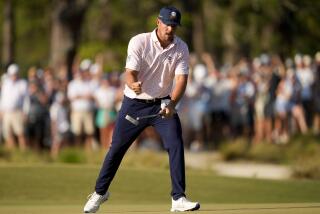Calling U.S. Open course tough is an understatement
- Share via
Reporting from Bethesda, Md. — The U.S. Open likes its status as the toughest of the tough. If triple bogeys outnumbered birdies here at Congressional, United States Golf Assn. officials would be thrilled.
Veteran pro Jeff Overton played a practice round Tuesday, stood next to the 18th green, gazed back up its hill after he had finished, and said, “They could make this so that seven over par would win. Easy.”
The course will play 7,574 yards, or 300 more than the last time they tortured the players here, in 1997. Then it was par 70. Now it is par 71.
Among its features are eight par fours over 460 yards, one par five of 636 yards and a par three of 233 yards. The highlight for the USGA thumbscrew crew is the finishing hole, a 523-yard par four. Yes, 523 yards — but that’s OK, because it’s downhill.
Here is Tom O’Toole, chairman of the USGA championship committee, describing his thoughts on No. 18: “So let me set the stage. Seventy-second hole, 523 yards, par four. Water on three sides. I’m envisioning a left hole location. And what hangs in the balance? The United States Open championship. Pretty good theater.”
‘Brutal’ test
Phil Mickelson, among the favorites to survive here and maybe even win, had his own thoughts.
“Unlike past U.S. Opens,” he said, “this one tests your entire game. It tests your short game. It tests your ability to hit recovery shots, as well as your ability to get the ball and keep the ball in play.”
He also said the way to play this course, and this event, is to realize that the hard holes are “brutal” and the easy holes are scoring chances and you have to recognize which is which.
Mickelson, the ultimate hard-charging, go-for-it player, said that his approach would be to “control my misses and salvage pars the hard way.”
He digs it
Graeme McDowell, defending champion, praised the course setup and then complained that there was so much sand in the bunkers that every time he practiced he saw four or five shots buried.
Fast track
When McDowell won last year at Pebble Beach, the speed of the greens was measured at an average of 11 on the Stimpmeter. The USGA can’t do much about seaside greens such as those at Pebble, but it likes the greens much faster. It said it will shoot for a 14 here at Congressional.
That’s like putting on a gym floor.
Looking ahead
The USGA announced that it would be returning to Shinnecock Hills on eastern Long Island for the 2018 U.S. Open. That was a slight surprise because last time it was held there, the 2004 tournament won by Retief Goosen, it became a fiasco when overnight winds dried the greens so badly — especially No. 7 — that the players were putting off the green into bunkers. With the field halfway through, the USGA stopped play and watered the green.
The decision also postponed any return to Torrey Pines, which played host to the highly successful 2008 tournament won on the 19th hole of a Monday playoff by Tiger Woods.
With Shinnecock Hills getting 2018 and Pebble Beach having it in 2019, Torrey will have to wait until at least 2021, since the USGA is unlikely to be in California two years in a row.
Next year’s U.S. Open is at Olympic Club in San Francisco, followed by Merion, Pa.; Pinehurst (N.C.) No. 2; Chambers Bay, Wash.; Oakmont, Pa., and Erin Hills, Wis., in 2017, preceding Shinnecock Hills and Pebble Beach.
More to Read
Go beyond the scoreboard
Get the latest on L.A.'s teams in the daily Sports Report newsletter.
You may occasionally receive promotional content from the Los Angeles Times.











